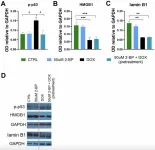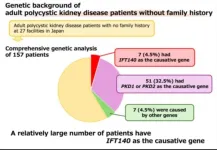(Press-News.org) New research published in The Lancet and presented at this year’s Annual Meeting of the European Association for the Study of Diabetes (EASD) in Madrid (9-13 Sept) shows that a new class of insulin that only needs to be injected once weekly is as effective as daily insulin injections for effective blood sugar management in patients with type 1 diabetes. However, higher rates of hypoglycaemia using the new class means vigilance is needed for dose initiation and optimisation. The study is by Dr Richard M Bergenstal, International Diabetes Center, HealthPartners Institute, Minneapolis, MN, USA, and colleagues.
The previous phase 2 study of weekly insulin efsitora alfa in people with type 1 diabetes showed non-inferior glycated haemoglobin (HbA1c) (a measure of blood sugar control) reduction compared with daily insulin degludec without increased combined level 2 (<54 mg/dl [3.0 mmol/l) or level 3 hypoglycaemia over 26 weeks of treatment, but with statistically significantly higher glycated haemoglobin and fasting glucose than degludec.
Thus, in this new phase 3 study, a new dosing approach was implemented in the QWINT-5 study based on the phase 2 results to balance glycaemic efficacy with hypoglycaemia risk. This randomised 52-week study conducted at 82 global health-care centres, randomly assigned (1:1) adults aged over 18 years with type 1 diabetes glycated haemoglobin 7.0 - 10.0% (53.0–85.8 mmol/mol) to efsitora (n=343) or, degludec (n=349), both in combination with insulin lispro. Insulin lispro was used to have a consistent ‘meal time’ insulin in both groups, so that the only insulin difference in the two treatment arms was the type of background or ‘basal’ insulin. The primary endpoint was the change in HbA1c from baseline to week-26 (noninferiority margin=0.4%).
Between Aug 12, 2022, and May 7, 2024, 893 participants enrolled, 692 (77%) participants were randomly assigned to once-weekly efsitora or once-daily degludec, and 623 (90%) participants completed the study. Mean HbA1cdecreased from 7.88% (62.66 mmol/mol) at baseline to 7.41% (57.5 mmol/mol) at week 26 with efsitora and from 7.94% (63.3 mmol/mol) at baseline to 7.36% (56.9 mmol/mol) at week 26 with degludec. Mean HbA1c change from baseline to week 26 was –0.51% with efsitora and –0.56% with degludec (estimated treatment difference 0.052%) confirming a non-inferiority margin of 0.4% for efsitora compared with degludec.
Rates of combined level 2 (<54 mg/dL [3.0 mmol/L]) or level 3 severe hypoglycaemia were higher with efsitora compared with degludec (14.03 vs 11.59 events per patient year of exposure; an increased risk of 21% (statistically significant) for patients receiving efsitora during weeks 0–52, with the highest rates during weeks 0–12. Severe hypoglycaemia incidence was higher with efsitora (35 [10%] of 343) versus degludec (11 [3%] of 349) during weeks 0–52. Overall incidence of treatment-emergent adverse events was similar across treatment groups. One death not related to the study treatment occurred in the degludec group.
Dr Bergenstal concludes: “Our study showed that once-weekly efsitora improved HbA1c in people with type 1 diabetes with similar HbA1c reduction to degludec. More work is needed to evaluate efsitora dose initiation and optimisation of basal-bolus insulin dosing to maintain efficacy while mitigating the risk of hypoglycaemia with weekly efsitora treatment in people with type 1 diabetes.”
END
New class of weekly insulin as effective as daily injections for managing blood sugar in patients with type 1 diabetes; but higher rates of hypoglycaemia means vigilance needed (QWINT-5)
2024-09-10
ELSE PRESS RELEASES FROM THIS DATE:
Like father, like daughter
2024-09-10
RIVERSIDE, Calif. -- When they become fathers, men who have an unhealthy, high-cholesterol diet can cause increased risk of cardiovascular disease, or CVD, in their daughters, a University of California, Riverside-led mouse study has found.
The research, published in the journal JCI Insight, is the first to demonstrate this result seen only in female offspring.
CVD, the leading cause of death globally, is a group of disorders that affects the heart and blood vessels. Hypertension (high blood pressure) is a leading risk factor ...
2-bromopalmitate reduces senescence in human cells: Role of palmitoylation
2024-09-10
“For the first time, the present study revealed a critical role for protein palmitoylation in the development of a DNA damage-induced senescence phenotype.”
BUFFALO, NY- September 10, 2024 – A new research paper was published in Aging (listed by MEDLINE/PubMed as "Aging (Albany NY)" and "Aging-US" by Web of Science), Volume 16, Issue 16 on August 23, 2024, entitled, “2-Bromopalmitate treatment attenuates senescence phenotype in human adult cells - possible role of palmitoylation.”
As ...
Don’t judge a fossil by its teeth: despite its toothy beak, this ancient bird ate fruit, not fish
2024-09-10
For paleontologists who study animals that lived long ago, fossilized remains tell only part of the story of an animal’s life. While a well-preserved skeleton can provide hints at what an ancient animal ate or how it moved, irrefutable proof of these behaviors is hard to come by. But sometimes, scientists luck out with extraordinary fossils that preserve something beyond the animal’s body. Case in point: in a new study published in the journal Current Biology, researchers found fossilized seeds in the stomachs of one of the earliest birds. This discovery shows that these birds were eating ...
A new screening tool to improve telehealth access and equity
2024-09-10
In a new study published in JAMA Network Open, researchers at Thomas Jefferson University have developed a novel screening tool to measure digital health readiness, which will be critical in addressing barriers to telehealth adoption among diverse patient populations.
The COVID-19 pandemic facilitated many rapid changes in healthcare, including a shift to using telehealth services across the U.S. instead of traditional in-person doctor’s visits. This ensured that patients continued to receive vital care, while only needing access to a mobile device or computer with a webcam. But just because a ...
New law regulating out-of-pocket drug spending saves cancer patients more than $7,000 a year, study finds
2024-09-10
For more information, contact:
Nicole Fawcett, nfawcett@umich.edu
EMBARGOED for release at 11 a.m. Sept. 10, 2024
New law regulating out-of-pocket drug spending saves cancer patients more than $7,000 a year, study finds
The Inflation Reduction Act’s limit on Medicare Part D spending leads to significant savings for patients prescribed oral chemotherapy
ANN ARBOR, Michigan — As prescription oral chemotherapies have become a common form of cancer treatment, some patients were paying more than $10,000 a year for medications. A new study ...
Estimated health and economic outcomes of racial and ethnic tuberculosis disparities in US-born persons
2024-09-10
About The Study: In this modeling study of racial and ethnic disparities of tuberculosis (TB), these disparities were associated with substantial future health and economic outcomes of TB among U.S.-born persons without interventions beyond current efforts. Actions to eliminate disparities may reduce the excess TB burden among these persons and may contribute to accelerating TB elimination within the U.S.
Corresponding Author: To contact the corresponding author, Nicole A. Swartwood, MSPH, email nswartwood@hsph.harvard.edu.
To ...
Genetic analysis sheds light on the role of IFT140 in polycystic kidney disease
2024-09-10
Tokyo Medical and Dental University (TMDU) researchers uncover the genetic link in patients with polycystic kidney disease lacking family history
Tokyo, Japan – Polycystic kidney disease (PKD) is an intractable disorder that causes fluid-filled cysts to grow in the kidneys. It is typically seen in adults. As one of the most prevalent hereditary kidney diseases, the autosomal dominant form of PKD is usually caused by mutations in the PKD1 and PKD2 genes. However, one out of ten patients with this condition typically exhibit no family history of the disease and lack ...
Scientists use AI to detect chronic high blood pressure in people’s voice recordings
2024-09-10
NEW YORK/TORONTO – September 10, 2024 – Researchers at Klick Labs unveiled a cutting-edge, non-invasive technique that can predict chronic high blood pressure (hypertension) with a high degree of accuracy using just a person's voice. Just published in the peer-reviewed journal IEEE Access, the findings hold tremendous potential for advancing early detection of chronic high blood pressure and showcase yet another novel way to harness vocal biomarkers for better health outcomes.
The ...
NIH Kids First Program announces the release of three new pediatric research datasets exploring childhood rare disease
2024-09-10
WHO: The Gabriella Miller Kids First Pediatric Research Program (Kids First), an initiative of the National Institutes of Health (NIH)
WHAT: Kids First announces the release of three comprehensive new pediatric research datasets exploring childhood cancers and congenital disorders. New publicly available datasets include:
CHILDHOOD CANCERS
Gabriella Miller Kids First (GMKF) Pediatric Research Program in Susceptibility to Ewing Sarcoma Based on Germline Risk and Familial History of Cancer.
Principal Investigators: Joshua D. Schiffman, MD. Huntsman Cancer Institute, ...
Pressure sensing by muscles is a promising new target for treatments
2024-09-10
A new study from Umeå University, Sweden, shows that the body's muscles sense mechanical pressure. This new discovery has important implications for movement neuroscience and may improve the design of training and rehabilitation to relieve stiff muscles.
"The results provide an important piece of the puzzle in understanding what information our nervous system receives from muscles," says Michael Dimitriou, associate professor at the Department of Medical and Translational Biology, ...




